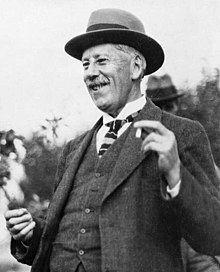Sir Thomas Hill Easterfield KBE (4 March 1866 – 1 March 1949) was born in Doncaster the youngest of four children of Edward Easterfield, savings bank secretary, and Susan (née Hill). He attended Doncaster Grammar School, and later entered the Yorkshire College of Science, now the University of Leeds. He was then appointed a Senior Foundation Scholar of Clare College, Cambridge, from where he gained First Class honours in the Natural Sciences Tripos in 1886.[1]
Sir Thomas Easterfield | |
|---|---|
 Easterfield c. 1926 | |
| Born | Thomas Hill Easterfield 4 March 1866 |
| Died | 1 March 1949 (aged 82) Nelson, New Zealand |
| Resting place | Ashes scattered at Cawthron Institute |
| Alma mater | Clare College, Cambridge |
| Spouse | Anna Maria Kunigunda Büchel |
| Children | 5 |
| Relatives |
|
| Scientific career | |
| Institutions |
|
| Notable students | Sir Theodore Rigg |
After graduation Easterfield worked in the Technische Hochschule Zürich, the University of Zürich, and later in the University of Würzburg under Emil Fischer, from where he was awarded a PhD in 1894 for his work on citrazinic acid.[1]
In 1888 Easterfield returned to Cambridge as a junior demonstrator in the chemistry department. He was appointed a lecturer in the University Extension programme in 1891[2] and in 1894 lecturer on pharmaceutical chemistry and chemistry of sanitary science; he was also a master at The Perse School.[3]
In 1899 Easterfield was appointed one of the four foundation professors of the Victoria University of Wellington, New Zealand; he and their two daughters set sail for the 90 day voyage on the Kaikoura from Plymouth on 11 February. In 1919 he became the first director of the Cawthron Institute, Nelson;[4] he retired from there in 1933.
Easterfield isolated the chemical compounds Totarol, Cannabinol[5][6] and Tutin.[1]
In 1935 he was awarded the King George V Silver Jubilee Medal.[7] He was appointed a Knight Commander of the Order of the British Empire in the 1938 King's Birthday Honours.[8]
Academic society memberships
edit- Foundation member of the New Zealand Institute (later the Royal Society of New Zealand Te Apārangi); President in 1921–22
- Nelson Philosophical Society; several times President
- The Australian and New Zealand Association for the Advancement of Science; President of the Chemistry Section 1909
- Foundation member of the New Zealand Institute of Chemistry
- Life Fellow of the Royal Institute of Chemistry of Great Britain and Ireland
Family
editThomas Easterfield met Anna Maria Kunigunda Büchel while he was working in Würzburg and they married there on 1 September 1894. They had five children, the first two born in England and the others in New Zealand:
- Margaret Anna
- Beatrice Mary
- Muriel Helen
- Theodora Clemens
- Thomas Edward
Sir Thomas Hill Easterfield died in Nelson, New Zealand on 1 March 1949. His ashes were scattered in a garden nook at the Cawthron Institute.[9]
[He] will ever be remembered as an outstanding chemist who created from virtually nothing—much of the equipment was of his own making—the Department of Chemistry at Victoria College, Wellington, successfully fathering such an undertaking through all vicissitudes,
— David Miller[3]
References
edit- ^ a b Askew, H. O. (1950). "OBITUARY Thomas Hill Easterfield (1866–1949)". Transactions and Proceedings of the Royal Society of New Zealand. 78: 381–383. Retrieved 6 March 2023.
- ^ Browning, Oscar (21 January 1887). "The University Extension Movement at Cambridge". Science. 9 (207): 61–63. Bibcode:1887Sci.....9...61B. JSTOR 1760197.
- ^ a b Miller, David (30 April 1949). "Obituaries: Sir Thomas Hill Easterfield, K.B.E." Nature. 163 (4148): 669. Bibcode:1949Natur.163..669M. doi:10.1038/163669a0. S2CID 4087016.
- ^ MacKay, Deidre (2011). An Appetite for Wonder. Nelson, New Zealand: Cawthron Institute. p. 35. ISBN 978-0-473-19588-5.
- ^ Appendino, Giovanni (1 December 2020). "The early history of cannabinoid research". Rendiconti Lincei. Scienze Fisiche e Naturali. 31 (4): 919–929. doi:10.1007/s12210-020-00956-0. ISSN 2037-4631. S2CID 222179431.
- ^ Wood, Thomas Barlow; Spivey, W. T. Newton; Easterfield, Thomas Hill (1 January 1899). "III.—Cannabinol. Part I". Journal of the Chemical Society, Transactions. 75: 20–36. doi:10.1039/CT8997500020. ISSN 0368-1645.
- ^ "Official jubilee medals". Evening Post. 6 May 1935. p. 4. Retrieved 2 July 2013.
- ^ "No. 34518". The London Gazette (Supplement). 9 June 1938. p. 3701.
- ^ Miller, David (1 April 1949). "Sir Thomas Hill Easterfield, K.B.E". Nature. 163 (4148): 669. Bibcode:1949Natur.163..669M. doi:10.1038/163669a0. ISSN 0028-0836. S2CID 4087016.
- Davis, Brian R. "Thomas Hill Easterfield". Dictionary of New Zealand Biography. Ministry for Culture and Heritage. Retrieved 31 December 2012.
- Marsden, E. (1952). "Obituary notices: Thomas Hill Easterfield, 1866–1949". Journal of the Chemical Society: 1557–1560. doi:10.1039/JR9520001557. Retrieved 31 December 2012.
- Askew, H. O. (1950). "OBITUARY Thomas Hill Easterfield (1866–1949)". Transactions and Proceedings of the Royal Society of New Zealand. 78: 381–383. Retrieved 31 December 2012.
- Miller, David (30 April 1949). "Sir Thomas Hill Easterfield, K.B.E". Nature. 163 (4148): 669. Bibcode:1949Natur.163..669M. doi:10.1038/163669a0.
- Barrowman, Rachel (1999). Victoria University of Wellington 1899 ~ 1999 A History. Wellington: Victoria University Press. pp. 15–17.